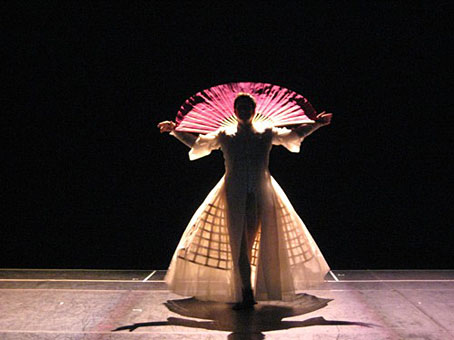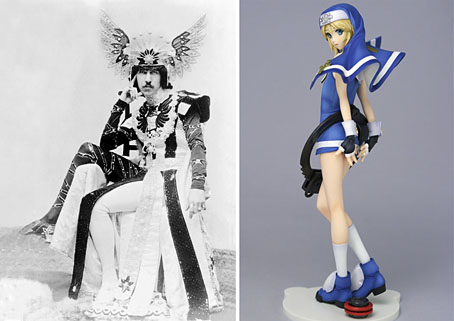
The Chevalier d’Eon wins a fencing bout.
I’ve known of the cross-dressing Charles-Geneviève-Louis-Auguste-André-Thimothée d’Eon de Beaumont—or the Chevalier d’Eon (1728–1810) to give him his title—for some time thanks to a typically witty and informative entry by Philip Core in Camp: The Lie that Tells the Truth (1984). The nobleman rubs shoulders there with the equally flamboyant Henry Paget (1875–1905), Fifth Marquess of Anglesey, known as “the Dancing Marquess”, and Romain de Tirtoff, better known as illustrator and designer, Erté, who we see in a photo dressed as “Claire de Lune”. Aside from his status as a historical curio, and a failed attempt by Havelock Ellis to borrow his name to describe transvestism—Eonism, the Chevalier seems less celebrated than he might be. So it’s a pleasure to hear that theatre director Robert Lepage has created a new stage production, Eonnagatta, based on the Chevalier’s colourful life:
For a long time now, the actor and experimental theatre director Robert Lepage has been fascinated by the life of the Chevalier d’Eon, an 18th-century French soldier who had a flamboyant career as a diplomat and secret agent for Louis XV, and spent much of his adult life dressed as a woman. Officially, the Chevalier’s skirts were worn as a professional disguise: his exceptionally fine features allowed him to pass easily for a woman, and thus move around undetected as a spy. But the Chevalier didn’t just do it for the job. He was a genuine cross-dresser, an 18th-century transvestite.
Lepage’s fascination has now led to Eonnagata, a daring collaboration inspired by the life of the Chevalier that gets its British premiere next week. The work has been put together by four very different, and internationally acclaimed, artists: there’s Lepage, the choreographer Russell Maliphant, the dancer Sylvie Guillem and the fashion designer Alexander McQueen. That’s quite a team – and the result is a unique hybrid of their art forms. How would they describe it? Maliphant gives it a go: “It’s not pure dance: it doesn’t have Sylvie doing splits or amazing falls. But it’s not pure theatre, either.” (More.)

Eonnagata.
So, a camp character from a camp era, then, although the Chevalier slightly predates the Regency camp of Beau Brummell and his foppish entourage. D’Eon was renowned for his prowess as a swordsman and despite its lethal nature there’s something camp about the swordfight, especially in its 18th century incarnation when fencing matches reduced the deadly art of the rapier duel to a mannered, rule-bound sport rather like a ballet with weapons. Being a spy for Louis XV, the Chevalier’s swordplay would have been a serious business and there’s something satisfying about the engraving above which shows him besting an opponent in a fencing match for the English Prince Regent; this was a man who was capable of defending his non-conformity to the utmost.
The unusual title of Lepage’s stage production is derived from the onnagata, male actors in Japanese kabuki who perform female roles. This tradition may explain why the Chevalier’s character has also been used as the basis for a recent Japanese anime series, Chevalier: Le Chevalier D’Eon, one of the few fictional manifestations of his life.
D’Eon is a member of the Secret Police, working in the shadows to keep the peace within French society. When his sister suddenly turns up floating down a river in a coffin with ‘Psalms’ written on it, D’Eon is thrown into a deadly struggle with revolutionaries and supernatural forces in order to uncover the truth behind his sister’s death. D’Eon looks remarkably like Lia, which turns to his advantage whenever he needs to meet with a ruler who was once Lia’s friend.

left: The Dancing Marquess relaxes; right: Bridget from Guilty Gear.
Given the way that most anime boys are distinctly androgynous, he wouldn’t have to try too hard to impersonate his sister. And impersonation gives a boy an excuse to drag up, of course, rather than leaving the series writers to tackle (or ignore) the adventure-unfriendly issue of gender confusion or transvestism. Japanese culture seems far more open to this kind of identity play than we’re used to here. The character of Bridget in fighting game Guilty Gear, for example, is actually a boy who was “born in a village where the birth of twins of the same gender was considered bad luck, and hence his family named and raised him as a girl.” Can you imagine American film or TV executives approving a story—for kids, yet—with a cross-dressing central character? Neither can I. I’ve yet to see any anime which can hold my attention for long but Chevalier may be worth seeking out. If anyone has seen it, please leave a comment.
Eonnagata runs from 26 Feb–8 Mar 2009 at Sadler’s Wells Theatre, London.
Elsewhere on { feuilleton }
• The men with swords archive


There are a lot of manga titles with transgendered and gay characters (hey, there are even whole genres). How they’re represented pretty much covers the whole gamut — from very serious to very silly, and from very clean to very smutty. And, of course, it seems like a mix of some or all of those is very popular.
Scanlations are pretty easy to find online, and give you a chance to check things out without making a financial commitment. They’re also a way to read books that haven’t been (and probably won’t be) published in English, which includes a lot of these titles (although there are a surprising number of “boy’s love” titles available in English these days, and even some of the crossgender stories seem to show up in surprising places; for example, Shojo Beat magazine has featured previews of Otomen and Heaven’s Will in recent issues).
I’ve never really seen a good explanation for why LGBT characters are so popular in Japan. Outside of manga, Japan’s culture doesn’t seem especially fond of people trying to live lives outside of the mainstream, but maybe that’s changing, or maybe they’re just more willing to provide an outlet for people’s imaginations rather than tolerate the expression in real life.
Hi Claire. Yes, I should have mentioned manga since I’m more familiar with that–albeit in a limited way–than with the anime world. These posts sprawl too easily into wide-ranging essays if you don’t keep a grip.
The whole boy’s love/yaoi genre is pretty unprecedented and, as far as I can tell, seems more popular here among gay males than the teenage girls who comprise much of the Japanese audience. The growing popularity of manga has been good to see and, as you note, people don’t even have to wait for reprints when they can find stories online.
The Japanese not being worried by the roamings of the imagination seems to be the key. It would have been quite simple to make that anime with a different name and drop the whole connection to the real Chevalier. Someone obviously liked the cross-dressing aspect, there’s no reason to have made it otherwise. The immediate reaction from a Western studio would be a worry about the response: “Oh no, boys will start wearing dresses!” Like that’s a bad thing.
This sort of thing has been going on for years. Around ten years ago Western TV companies got themselves into a dreadful state over Sailor Moon, which was hugely popular at the time. As I recall, Series 6 featured two new characters who were a lesbian couple. The TV stations got around that with bad re-writes that made them out to be “sisters”. Then Series 7 came out, featuring a whole new group of characters who were boys in their normal lives but girls when they transformed into sailor scouts. That got banned.
But I’m always reluctant to read too much into what other cultures do if you don’t understand them. Other people have told me that adult Japanese are very rigid about gender roles. It may well be that this gender-bending is something that is regarded as OK for children, but not for adults, in much the same way that many people in Britain think that you should “grow out” of reading fantasy literature when you get older. I’m hoping that one day I can find some Japanese gender scholars to talk to about it.
Heh, funny to think of something as innocuous as Sailor Moon causing such a fuss.
As well as the possibility that this is something found mostly in stories for kids, I might be guilty of the reverse of the outraged Western response; reading too much of a positive note into something the Japanese creators may not have thought about very much at all.
I don’t know about it being “just for kids”. Certainly the manga that I’ve seen are aimed at adolescents rather than younger kids, and some of it is definitely more adult-oriented. And while many of the stories play the whole thing for laughs and nothing else, there are also some — such as Family Compo, IS, Hourou Musuko, Day of Revolution — that at least have a serious side to them (some of those are about intersexed people rather than transgendered people, as well). What that really means for intersex and transgender people in Japan, of course, isn’t clear, although some googling suggests that there has been some changes in law and practice in Japan to accommodate transgendered people.
Japan definitely seems like a weird place, at least from my perspective, although I’m sure that tehy feel the same way about our culture(s).
I saw eonnagata tonight and thought it was wonderful – quite breathtaking in parts, by no means perfect but all the better for that. Too tired to be any more articulate!
What I just wanted to mention in the context of the anime/manga discussion is that the piece also draws connections between the Chevalier and the onnagata – Kabuki actors trained solely to perform female roles. Perhaps this tradition, which continues to the present day, might indicate a cultural familiarity in Japan with cross-dressing and which has helped it to emerge in manga / anime.
Also makes me wonder what would have happened here if the practice of men playing the female roles in Elizabethan England had continued to the present day.